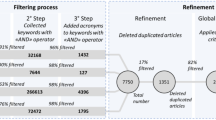Abstract
This paper presents the optimization of a dry machining process where thermomechanical effects like shape deviations and a time-dependent domain are major challenges. First, the simulation model to compute finite element approximations to a general milling process is presented. The model includes a submodel (dexel model) for material removal and process forces and heat flux introduced by the machining tool. In a second part, we present a multiobjective optimization algorithm based on metamodels that serve as a tool to identify the process parameters that improve processes with different performance measures that exhibit conflicting behavior. With this metamodel-based optimization method, we avoid the use of a large number of high-fidelity computer simulations, which are commonly computationally expensive. The approach is tested on two case studies for optimizing (a) workpiece deformation and equivalent stress after milling, and (b) shape error and tool wear.
Access this article
We’re sorry, something doesn't seem to be working properly.
Please try refreshing the page. If that doesn't work, please contact support so we can address the problem.
Similar content being viewed by others
References
Barton RR (2009) Simulation optimization using metamodels. In: Winter Simulation Conference, pp 230–238. Winter Simulation Conference
Caldeirani-Filho J, Diniz AE (2002) Influence of cutting conditions on tool life, tool wear and surface finish in the face milling process. J Braz Soc Mech Sci 24(1):10–14. https://doi.org/10.1590/S0100-73862002000100002
Denkena B, Maaß P, Schmidt A, Niederwestberg D, Vehmeyer J, Niebuhr C, Gralla P (2017) Thermomechanical deformation of complex workpieces in milling and drilling processes. In: Biermann D, Hollmann F (eds) Thermal Effects in Complex Machining Processes - Final Report of the DFG Priority Program 1480, LNPE Series. Springer. to appear, p 32
Denkena B, Schmidt A, Henjes J, Niederwestberg D, Niebuhr C (2013) Modeling a thermomechanical NC-simulation. Procedia CIRP 8:69–74
Denkena B, Schmidt A, Maaß P, Niederwestberg D, Niebuhr C, Vehmeyer J (2015) Prediction of temperature induced shape deviations in dry milling. Procedia CIRP 31:340–345
Dong S, Chunsheng E, Fan B, Danai K, Kazmer DO (2007) Process-driven input profiling for plastics processing. J Manuf Sci Eng 129(4):802–809
Jin R, Chen W, Sudjianto A (2002) On sequential sampling for global metamodeling in engineering design. In: ASME 2002 International Design Engineering Technical Conferences and Computers and Information in Engineering Conference, pp 539–548. American Society of Mechanical Engineers
Kok SW, Tapabrata R (2005) A framework for design optimization using surrogates. Eng Optim 37(7):685–703. https://doi.org/10.1080/03052150500211911
Li J, Yang X, Ren C, Chen G, Wang Y (2015) Multiobjective optimization of cutting parameters in ti-6al-4v milling process using nondominated sorting genetic algorithm-ii. Int J Adv Manuf Technol 76(5):941–953. https://doi.org/10.1007/s00170-014-6311-8
Li YF, Ng SH, Xie M, Goh TN (2010) A systematic comparison of metamodeling techniques for simulation optimization in decision support systems. Appl Soft Comput 10(4):1257–1273. https://doi.org/10.1016/j.asoc.2009.11.034
Montalvo-Urquizo J, Akbay Z, Schmidt A (2009) Adaptive finite element models applied to the laser welding problem. Comput Mater Sci 46(1):245–254. https://doi.org/10.1016/j.commatsci.2009.02.037
Montalvo-Urquizo J, Bobrov P, Schmidt A, Wosniok W (2012) Elastic responses of texturized microscale materials using FEM simulations and stochastic material properties. Mechanics of Materials 47:1–10. https://doi.org/10.1016/j.mechmat.2011.11.008
Niebuhr C, Niederwestberg D, Schmidt A (2014) Finite element simulation of macroscopic machining processes – implementation of time dependent domain and boundary conditions. Berichte aus der Technomathematik, Universität Bremen, pp 14–01
Qu S, Zhao J, Wang T (2017) Experimental study and machining parameter optimization in milling thin-walled plates based on nsga-ii. Int J Adv Manuf Technol 89(5):2399–2409. https://doi.org/10.1007/s00170-016-9265-1
Rao RV (2011) Advanced modeling and optimization of manufacturing processes. Springer Series in Advanced Manufacturing, Berlin
Schmidt A, Bänsch E, Jahn M, Luttmann A, Niebuhr C, Vehmeyer J (2017) Optimization of engineering processes icluding heating and time-dependent domains. In: Bociu L, Desideri J, Habbal A (eds) System Modeling and Optimization, 27th IFIP TC 7 Conference, CSMO 2015, IFIP AICT Series, vol 494, pp 452–461. Springer
Schmidt A, Siebert K (2005) Design of adaptive finite element software: the finite element toolbox ALBERTA. Springer Heidelberg, Berlin
Simpson TW, Poplinski JD, Koch PN, Allen JK (2001) Metamodels for computer-based engineering design: survey and recommendations. Engineer Comput 17(2):129–150
Smith GT (2008) Cutting tool technology: industrial handbook. Springer, London. https://doi.org/10.1007/978-1-84800-205-0
Suhr B (2010) Simulation of steel quenching with interaction of classical plasticity and TRIP: numerical methods and model comparison. Logos Verlag, Berlin
Tschätsch H, Reichelt A (2009) Milling. In: Applied Machining Technology, pp 173–223. Springer Berlin Heidelberg, Berlin, Heidelberg. https://doi.org/10.1007/978-3-642-01007-1
Villarreal-Marroquin MG, Cabrera-Rios M, Castro JM (2011) A multicriteria simulation optimization method for injection molding. J Polym Eng 31(5):397–407
Villarreal-Marroquin MG, Po-Hsu C, Mulyana R, Santner TJ, Dean AM, Castro JM (2016) Multiobjective optimization of injection molding using a calibrated predictor based on physical and simulated data. Polymer Engineering & Science
Villarreal-Marroqun MG, Svenson JD, Sun F, Santner TJ, Dean AM, Castro JM (2013) A comparison of two metamodel-based methodologies for multiple criteria simulation optimization using an injection molding case study. J Polym Eng 33(3):193– 209
Wang GG, Shan S (2007) Review of metamodeling techniques in support of engineering design optimization. J Mech Des 129(4):370–380
Zhou H (2012) Computer modeling for injection molding: simulation, optimization, and control. Wiley, New York
Acknowledgments
The authors gratefully acknowledge the financial support by the Mexican National Council for Science and Technology (CONACYT) and the German Academic Exchange Service (DAAD) through the project “Simulación Numérica y Optimización para Procesos Dependientes del Tiempo en Ingeniería y Ciencias de los Materiales” (“Numerical Simulation and Optimization of Time Dependent Processes in Engineering and Materials Science”). The support given by the German Research Foundation (DFG) to the project “Thermomechanical Deformation of Complex Workpieces in Drilling and Milling Processes” within the DFG Priority Program 1480 “Modeling, Simulation and Compensation of Thermal Effects for Complex Machining Processes” is also acknowledged.
Author information
Authors and Affiliations
Corresponding author
Rights and permissions
About this article
Cite this article
Montalvo-Urquizo, J., Niebuhr, C., Schmidt, A. et al. Reducing deformation, stress, and tool wear during milling processes using simulation-based multiobjective optimization. Int J Adv Manuf Technol 96, 1859–1873 (2018). https://doi.org/10.1007/s00170-018-1681-y
Received:
Accepted:
Published:
Issue Date:
DOI: https://doi.org/10.1007/s00170-018-1681-y




